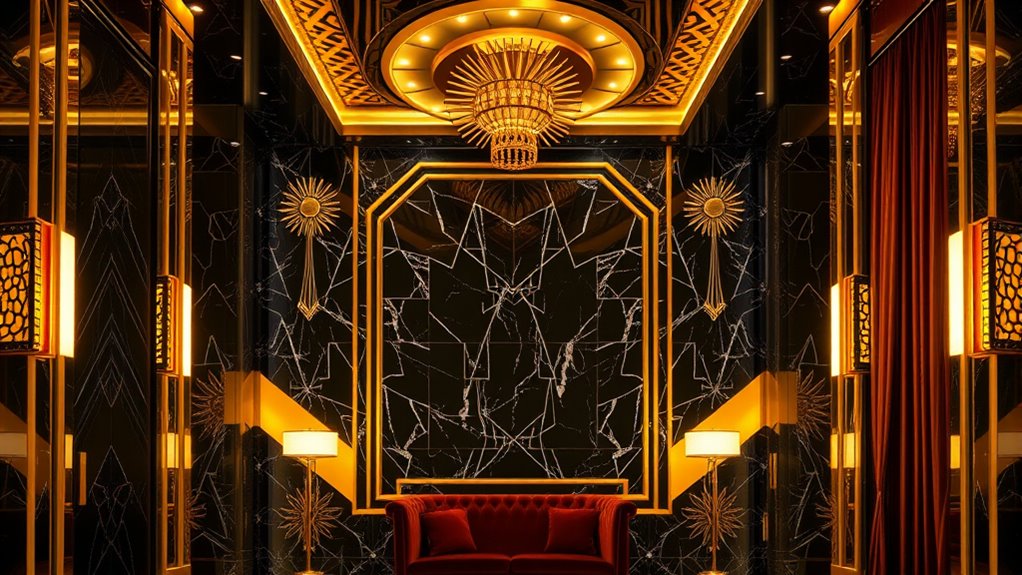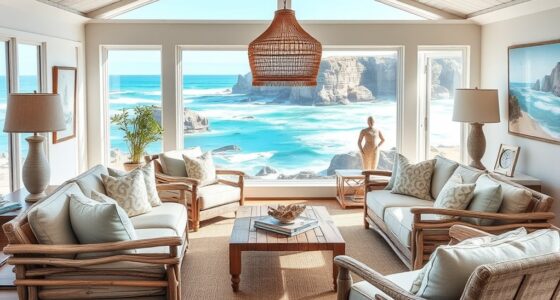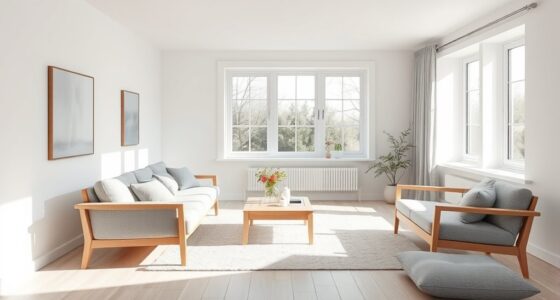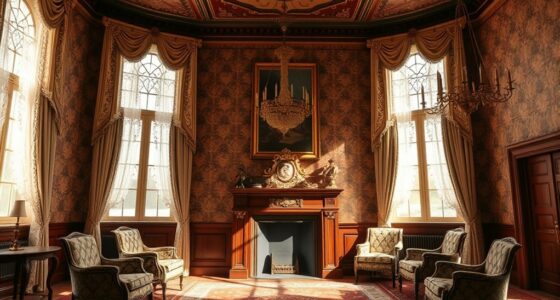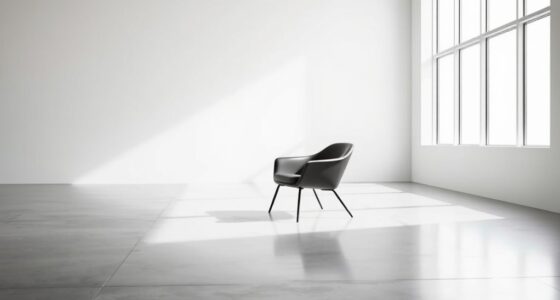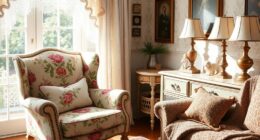You’ll see that Art Deco’s charm lies in its striking geometric patterns, like zigzags and chevrons, which evoke movement and modernity. It combines these designs with luxurious materials such as polished chrome, glossy lacquer, and gleaming marble, symbolizing wealth and elegance. Gold accents add a glamorous touch, creating a bold contrast that defines the style’s sophisticated energy. Exploring further reveals how these elements come together to embody an era of confidence and glamour.
Key Takeaways
- Art Deco combines bold geometric patterns like zigzags and chevrons to evoke movement and modernity.
- The style emphasizes symmetry and structured design to create a sense of order and dynamism.
- Luxurious materials such as polished chrome, marble, and exotic woods symbolize wealth and sophistication.
- Architectural features include stylized motifs, metallic finishes, and intricate inlays reflecting glamour and modernity.
- Art Deco’s distinctive fusion of geometry, glamour, and gold continues to inspire contemporary design and preservation efforts.
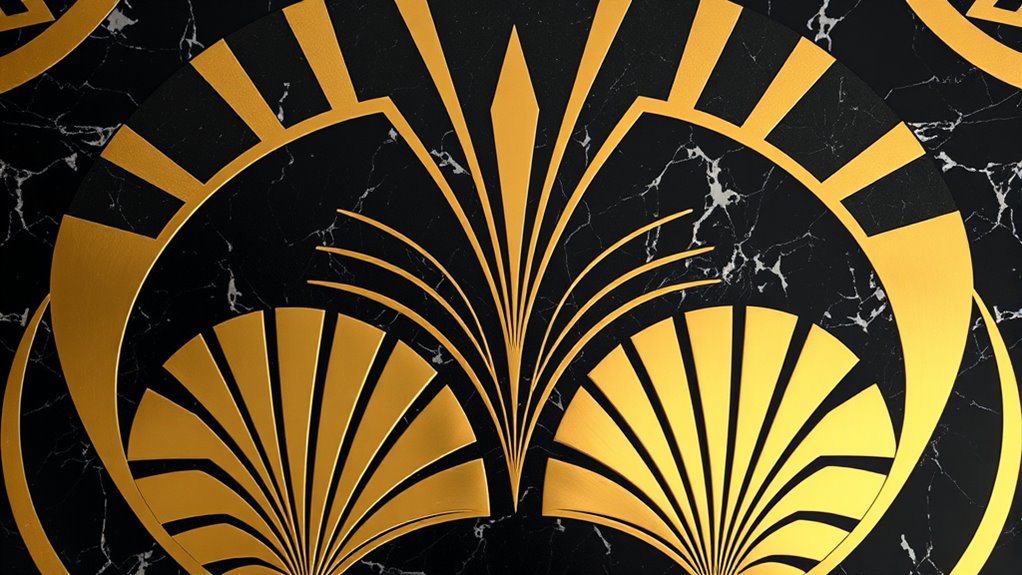
Have you ever wondered what makes Art Deco stand out among architectural and design styles? It’s the striking combination of geometric patterns and luxurious materials that instantly captures your attention. Art Deco emerged in the early 20th century, embodying modernity, elegance, and a sense of glamour. Its signature look is characterized by bold lines, symmetrical shapes, and intricate motifs that create a sense of movement and sophistication. When you look at an Art Deco building or piece of décor, you notice how the patterns are often composed of zigzags, chevrons, and stepped forms—geometric patterns that convey a sense of order and dynamism. These shapes aren’t random; they’re carefully designed to draw your eye and evoke a feeling of modernity and progress.
Art Deco’s bold geometric patterns and luxurious materials evoke modernity, glamour, and timeless sophistication.
The use of luxurious materials is another defining feature of Art Deco. You’ll find a rich palette of opulent finishes—polished chrome, glossy lacquer, gleaming marble, and exotic woods—used to elevate the aesthetic to a level of grandeur. These materials aren’t just chosen for their beauty; they symbolize wealth, success, and the desire to break away from traditional, more subdued styles. When you walk into an Art Deco space or see a piece of jewelry from the era, you can almost feel the tactile richness of these materials, which add depth and texture to the overall design. The combination of geometric patterns with luxurious materials creates a visual harmony that’s both bold and refined.
In architecture, this fusion manifests in facades decorated with stylized motifs, often accented with gold or metallic finishes that catch the light and add a touch of extravagance. Inside, you might notice mirrored surfaces and intricate inlays that reflect an obsession with glamour and modernity. The intentional use of geometric patterns and luxurious materials isn’t accidental; it’s a statement about the era’s confidence and optimism. It’s about embracing progress while indulging in the finest craftsmanship and materials available. Additionally, digital platforms and virtual environments have facilitated the preservation and study of Art Deco design, making it accessible to a broader audience and inspiring new generations of designers.
You can see the influence of this approach in everything from the elegant designs of Miami’s historic hotels to the sleek lines of vintage jewelry. Art Deco’s ability to combine geometric patterns with luxurious materials allows it to stand out as a style that celebrates both form and substance. When you understand these elements, you gain a deeper appreciation for how Art Deco captured the spirit of its time—fusing modern aesthetics with a luxurious touch that continues to inspire today.
Frequently Asked Questions
How Did Art Deco Influence Modern Architectural Design?
You see how art deco influences modern architecture through its streamlined aesthetics and use of luxury materials. It introduced bold geometric shapes, sleek lines, and decorative elements that still inspire contemporary designs. You notice how buildings today often feature geometric patterns and luxurious finishes, echoing art deco’s glamour. Its emphasis on elegance and modernity shapes the way architects blend form and function, creating striking, timeless structures.
What Are the Key Symbols Used in Art Deco Motifs?
You’ll notice that art deco motifs often feature key symbols like sunbursts, zigzags, and chevrons, which emphasize geometric patterns. These symbols, combined with luxurious materials like gold, chrome, and onyx, create a sense of glamour and opulence. You see these motifs in architecture, jewelry, and decorative arts, reflecting the era’s love for bold, symmetrical designs. They symbolize progress, elegance, and sophistication in art deco’s visual language.
Which Countries Were Central to the Art Deco Movement?
Imagine you’re exploring a vibrant city where styles collide—France and America stand out as key players. French influence brings elegance and intricate motifs, while American innovation injects boldness and modernity. These countries lead the Art Deco movement, shaping its glamorous designs and geometric patterns. You can see their impact in architecture, fashion, and art, creating a worldwide trend that symbolizes progress, luxury, and the Jazz Age’s lively spirit.
How Did Technological Advances Impact Art Deco Style?
Technological innovations and manufacturing advancements greatly influenced the Art Deco style. You’ll notice the use of new materials like aluminum, stainless steel, and plastics, which allowed for sleek, modern designs. These advancements made mass production possible, so you could see the luxury and glamour of Art Deco in everything from architecture to jewelry. By embracing technology, the movement became more accessible and reflected the rapid progress of the early 20th century.
Can Art Deco Be Incorporated Into Contemporary Interior Design?
Yes, you can incorporate Art Deco into contemporary interior design by blending luxury textures like velvet and lacquer with vibrant color schemes such as bold blues or gold accents. You’ll create a stylish space that feels both modern and glamorous, emphasizing geometric patterns and metallic finishes. This mix of old-world elegance and current trends allows you to craft a unique, sophisticated environment that captures the essence of Art Deco’s timeless allure.
Conclusion
As you step back from the dazzling world of Art Deco, you realize it’s more than just style—it’s a shimmering mirror of an era’s dreams and desires. Its bold geometry and golden glow invite you to dance in a time where glamour and innovation intertwined like stars in the night sky. Embrace its radiant spirit, and let it inspire your own creative journey, reminding you that beauty and brilliance are timeless treasures waiting to be rediscovered.
